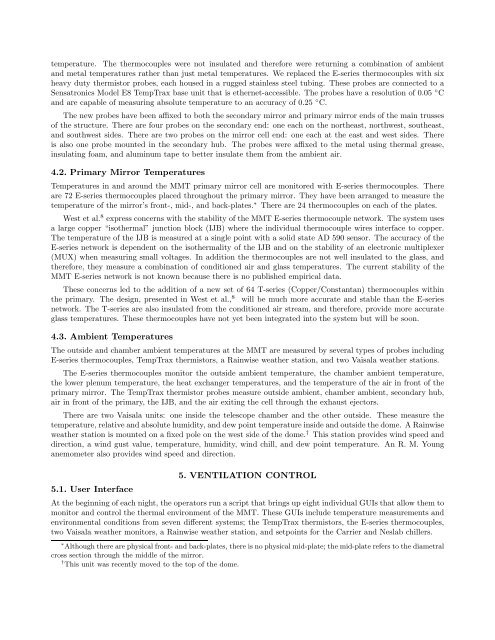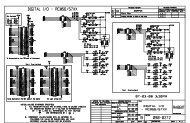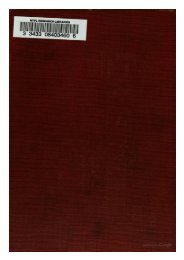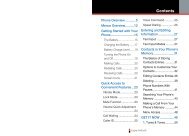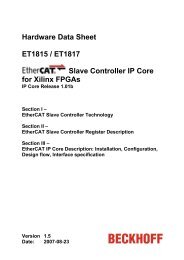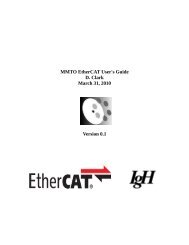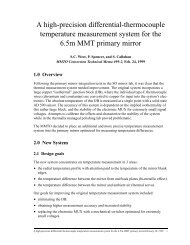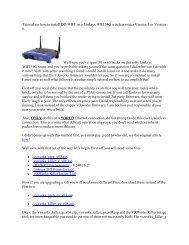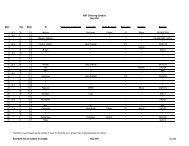Performance and control of the MMT thermal system
Performance and control of the MMT thermal system
Performance and control of the MMT thermal system
Create successful ePaper yourself
Turn your PDF publications into a flip-book with our unique Google optimized e-Paper software.
temperature. The <strong>the</strong>rmocouples were not insulated <strong>and</strong> <strong>the</strong>refore were returning a combination <strong>of</strong> ambient<strong>and</strong> metal temperatures ra<strong>the</strong>r than just metal temperatures. We replaced <strong>the</strong> E-series <strong>the</strong>rmocouples with sixheavy duty <strong>the</strong>rmistor probes, each housed in a rugged stainless steel tubing. These probes are connected to aSensatronics Model E8 TempTrax base unit that is e<strong>the</strong>rnet-accessible. The probes have a resolution <strong>of</strong> 0.05 ◦ C<strong>and</strong> are capable <strong>of</strong> measuring absolute temperature to an accuracy <strong>of</strong> 0.25 ◦ C.The new probes have been affixed to both <strong>the</strong> secondary mirror <strong>and</strong> primary mirror ends <strong>of</strong> <strong>the</strong> main trusses<strong>of</strong> <strong>the</strong> structure. There are four probes on <strong>the</strong> secondary end: one each on <strong>the</strong> nor<strong>the</strong>ast, northwest, sou<strong>the</strong>ast,<strong>and</strong> southwest sides. There are two probes on <strong>the</strong> mirror cell end: one each at <strong>the</strong> east <strong>and</strong> west sides. Thereis also one probe mounted in <strong>the</strong> secondary hub. The probes were affixed to <strong>the</strong> metal using <strong>the</strong>rmal grease,insulating foam, <strong>and</strong> aluminum tape to better insulate <strong>the</strong>m from <strong>the</strong> ambient air.4.2. Primary Mirror TemperaturesTemperatures in <strong>and</strong> around <strong>the</strong> <strong>MMT</strong> primary mirror cell are monitored with E-series <strong>the</strong>rmocouples. Thereare 72 E-series <strong>the</strong>rmocouples placed throughout <strong>the</strong> primary mirror. They have been arranged to measure <strong>the</strong>temperature <strong>of</strong> <strong>the</strong> mirror’s front-, mid-, <strong>and</strong> back-plates. ∗ There are 24 <strong>the</strong>rmocouples on each <strong>of</strong> <strong>the</strong> plates.West et al. 8 express concerns with <strong>the</strong> stability <strong>of</strong> <strong>the</strong> <strong>MMT</strong> E-series <strong>the</strong>rmocouple network. The <strong>system</strong> usesa large copper “iso<strong>the</strong>rmal” junction block (IJB) where <strong>the</strong> individual <strong>the</strong>rmocouple wires interface to copper.The temperature <strong>of</strong> <strong>the</strong> IJB is measured at a single point with a solid state AD 590 sensor. The accuracy <strong>of</strong> <strong>the</strong>E-series network is dependent on <strong>the</strong> iso<strong>the</strong>rmality <strong>of</strong> <strong>the</strong> IJB <strong>and</strong> on <strong>the</strong> stability <strong>of</strong> an electronic multiplexer(MUX) when measuring small voltages. In addition <strong>the</strong> <strong>the</strong>rmocouples are not well insulated to <strong>the</strong> glass, <strong>and</strong><strong>the</strong>refore, <strong>the</strong>y measure a combination <strong>of</strong> conditioned air <strong>and</strong> glass temperatures. The current stability <strong>of</strong> <strong>the</strong><strong>MMT</strong> E-series network is not known because <strong>the</strong>re is no published empirical data.These concerns led to <strong>the</strong> addition <strong>of</strong> a new set <strong>of</strong> 64 T-series (Copper/Constantan) <strong>the</strong>rmocouples within<strong>the</strong> primary. The design, presented in West et al., 8 will be much more accurate <strong>and</strong> stable than <strong>the</strong> E-seriesnetwork. The T-series are also insulated from <strong>the</strong> conditioned air stream, <strong>and</strong> <strong>the</strong>refore, provide more accurateglass temperatures. These <strong>the</strong>rmocouples have not yet been integrated into <strong>the</strong> <strong>system</strong> but will be soon.4.3. Ambient TemperaturesThe outside <strong>and</strong> chamber ambient temperatures at <strong>the</strong> <strong>MMT</strong> are measured by several types <strong>of</strong> probes includingE-series <strong>the</strong>rmocouples, TempTrax <strong>the</strong>rmistors, a Rainwise wea<strong>the</strong>r station, <strong>and</strong> two Vaisala wea<strong>the</strong>r stations.The E-series <strong>the</strong>rmocouples monitor <strong>the</strong> outside ambient temperature, <strong>the</strong> chamber ambient temperature,<strong>the</strong> lower plenum temperature, <strong>the</strong> heat exchanger temperatures, <strong>and</strong> <strong>the</strong> temperature <strong>of</strong> <strong>the</strong> air in front <strong>of</strong> <strong>the</strong>primary mirror. The TempTrax <strong>the</strong>rmistor probes measure outside ambient, chamber ambient, secondary hub,air in front <strong>of</strong> <strong>the</strong> primary, <strong>the</strong> IJB, <strong>and</strong> <strong>the</strong> air exiting <strong>the</strong> cell through <strong>the</strong> exhaust ejectors.There are two Vaisala units: one inside <strong>the</strong> telescope chamber <strong>and</strong> <strong>the</strong> o<strong>the</strong>r outside. These measure <strong>the</strong>temperature, relative <strong>and</strong> absolute humidity, <strong>and</strong> dew point temperature inside <strong>and</strong> outside <strong>the</strong> dome. A Rainwisewea<strong>the</strong>r station is mounted on a fixed pole on <strong>the</strong> west side <strong>of</strong> <strong>the</strong> dome. † This station provides wind speed <strong>and</strong>direction, a wind gust value, temperature, humidity, wind chill, <strong>and</strong> dew point temperature. An R. M. Younganemometer also provides wind speed <strong>and</strong> direction.5. VENTILATION CONTROL5.1. User InterfaceAt <strong>the</strong> beginning <strong>of</strong> each night, <strong>the</strong> operators run a script that brings up eight individual GUIs that allow <strong>the</strong>m tomonitor <strong>and</strong> <strong>control</strong> <strong>the</strong> <strong>the</strong>rmal environment <strong>of</strong> <strong>the</strong> <strong>MMT</strong>. These GUIs include temperature measurements <strong>and</strong>environmental conditions from seven different <strong>system</strong>s; <strong>the</strong> TempTrax <strong>the</strong>rmistors, <strong>the</strong> E-series <strong>the</strong>rmocouples,two Vaisala wea<strong>the</strong>r monitors, a Rainwise wea<strong>the</strong>r station, <strong>and</strong> setpoints for <strong>the</strong> Carrier <strong>and</strong> Neslab chillers.∗ Although <strong>the</strong>re are physical front- <strong>and</strong> back-plates, <strong>the</strong>re is no physical mid-plate; <strong>the</strong> mid-plate refers to <strong>the</strong> diametralcross section through <strong>the</strong> middle <strong>of</strong> <strong>the</strong> mirror.† This unit was recently moved to <strong>the</strong> top <strong>of</strong> <strong>the</strong> dome.


